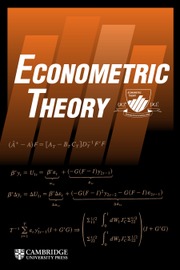Article contents
THIS SHOCK IS DIFFERENT: ESTIMATION AND INFERENCE IN MISSPECIFIED TWO-WAY FIXED EFFECTS PANEL REGRESSIONS
Published online by Cambridge University Press: 27 October 2025
Abstract
We investigate the properties of the linear two-way fixed effects (FE) estimator for panel data when the underlying data generating process (DGP) does not have a linear parametric structure. The FE estimator is consistent for some pseudo-true value and we characterize the corresponding asymptotic distribution. We show that the rate of convergence is determined by the degree of model misspecification, and that the asymptotic distribution can be non-normal. We propose a novel autoregressive double adaptive wild (AdaWild) bootstrap procedure applicable for a large class of DGPs. Monte Carlo simulations show that it performs well for panels of small and moderate dimensions. We use data from U.S. manufacturing industries to illustrate the benefits of our procedure.
Information
- Type
- ARTICLES
- Information
- Creative Commons
- This is an Open Access article, distributed under the terms of the Creative Commons Attribution-NonCommercial-NoDerivatives licence (https://creativecommons.org/licenses/by-nc-nd/4.0), which permits non-commercial re-use, distribution, and reproduction in any medium, provided that no alterations are made and the original article is properly cited. The written permission of Cambridge University Press must be obtained prior to any commercial use and/or adaptation of the article.
- Copyright
- © The Author(s), 2025. Published by Cambridge University Press
Footnotes
I would like to thank the Co-Editor Guido Kuersteiner and three anonymous referees for numerous suggestions that greatly improved this article. I would also like to thank Stephane Bonhomme, Tom Boot, Jorg Breitung, Denis Chetverikov, Ivan Fernandez-Val, Yi He, Aureo de Paula, Anders Bredahl Kock, Frank Kleibergen, Ryo Okui, Andres Santos, Vasilis Sarafidis, Gabriela Szini, Gautam Tripathi, Martin Weidner, Joakim Westerlund, as well as the participants of the 2021 International Panel Data Conference, 2023 Annual IAAE Conference (Oslo), and seminar participants at U Amsterdam, Oxford, UCLA, U Duisburg-Essen, U Lund, U Luxembourg, U Cologne, and Tinbergen Econometrics Workshop for helpful comments. Preliminary version of this article was completed while I enjoyed the hospitality of the Department of Economics at the University College London in May 2019. Financial support from the Netherlands Organization for Scientific Research (NWO) under research grant number 451-17-002 is gratefully acknowledged.
References
REFERENCES
- 1
- Cited by

